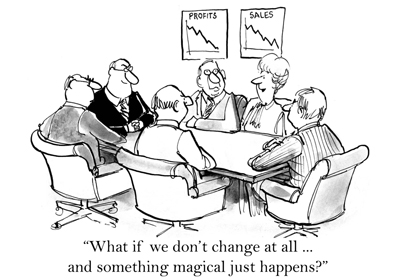We came across this recent article by Jose-Pedro Martinez at Blue Steps on implementing successful change management through communication and which is worth posting:
Have you ever been a part of a company’s failed attempt to boost quality, merge with another company, restructure the business or improve company culture? Chances are that as an executive leader, you have experienced this. As one of the many aspects of leadership, implementing a successful change management strategy is a vital part of any successful leadership team strategy.
Organisational change is a constant feature of modern organisations and the dependence upon successful project and programme delivery has never been higher. It’s not lack of money or know-how that’s causing most strategic initiative mishaps. The major causes often relate to insufficient communication across the company.
Business transformation is not an event; it’s a process that needs to develop stage by stage. Former Harvard Business School professor John P. Kotter outlined eight success factors that would determine the outcome of this process. One important factor was communication; and change management is a lot more than just communication, but without effective communication you cannot be successful when implementing change.
Communication should be open and honest. Get bad news out as soon as possible. If you don’t communicate it quickly, the grapevine usually finds and exaggerates the issue.
Communicating the organisation’s new vision will require your executive team to formulate a strategy and decide which vehicles are appropriate to use to inform the new vision. It is also important that new behaviours are aligned with this vision of open communication.
You can develop an extraordinary vision but if really your employees don’t understand the vision, it will not be implemented successfully. Communication comes in both words and deeds, and the latter is the most powerful form. Nothing undermines change more than behaviour that is inconsistent with your verbal communication.
Employees need to constantly sense what is happening around them. Nowadays there are so many communication channels available to people, there is no chance of being aware of everything being said about the change. Instead, leaders need to focus on making sure they hear what overall sentiments are being made so that they can contribute a different or corrective perspective.
Include employees in any new changes as early as possible so that they know that they are valued at the organisation and feel like they have been involved in the change process all along. Throughout the process company leaders should be asking their teams for input, such as, “How can we implement this here? and “What needs to be different for us to be able to…?”
Anytime a new strategic initiative needs to be launched, a communication plan must be set down. It is very important that senior leaders deliver steady messages and confidently convey that this change is necessary and that team members will benefit from it. This messaging emphasises goals, plans and expectations.
Like steady messaging, leaders can deliver cyclical messaging. These communications occur at planned intervals, but the content of cyclical messages adapts as the change project progresses. It might include, for example, emotional support from a manager working closely with those impacted.
Encouraging direct managers to ask “How’s the change going?” and “How might it go better?” will help executive leadership get feedback from the ground level. Besides making employees feel connected with organisational decisions, feedback can also help identify risks and craft solutions. It will always be necessary to use those feedback messages to assure a successful change.
When something unexpected happens or a new problem arises, situational messages provide short bursts of information when a stakeholder learns important new information or when a problem is identified and resolved.
The most effective communications plans take advantage of not just one of these messaging approaches, but a combination of them adapted to the varying needs of the strategic initiative and its stakeholders.
